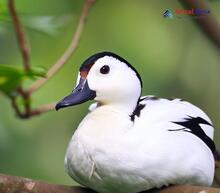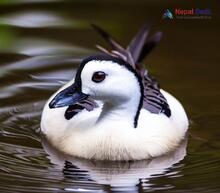The Nettapus genus, a captivating group of little ducks, is known for its one-of-a-kind features and striking markings. These extraordinary birds have captured the curiosity of bird lovers and ornithologists alike. In this article, we'll explore the beginnings, classification, organization, evolution, genetic history, species list, unique traits, and the existence of the Nettapus genus in Nepal.
Origin and Taxonomy:
Belonging to the Anatidae family of ducks, geese, and swans, Nettapus is a genus that was first described by French ornithologist Charles Lucien Bonaparte in 1838. Its name originates from the Greek words "nettá" meaning duck and "pus" meaning foot—a nod to the large swimming feet that make these small ducks so distinctive.
Systematics and Evolution Chain:
Nettapus' organization is intricate and has experienced considerable changes as scientists gather more knowledge about their evolutionary background. Genetic studies on their ancestry help us better understand the intricate relationship between various species in this genus—ultimately giving us a clearer picture of their evolution chain.
Genetic Phylogeny:
Recent advances in genetic research have deepened our understanding of the evolutionary links within Nettapus species. By merging traditional morphological research with molecular analysis, modern classification methods offer a more precise insight into their development over time. This has unveiled a surprising connection to certain diving ducks (Aythyinae).
Listing Species:
Three recognized species make up the Nettapus genus:
1. Green Pygmy Goose (Nettapus pulchellus)
2. Cotton Pygmy Goose (Nettapus coromandelianus)
3. African Pygmy Goose (Nettapus auritus)
Observing Species Characteristics:
These small ducks have short wings, big feet, and a sleek body shape — defining features of the Nettapus species. Males and females show visible differences – known as sexual dimorphism – with males displaying vibrant colors like radiant patches, while females portray softer hues and less noticeable markings. These birds are found in various wetland habitats such as marshes, ponds, and rivers.
Exploring Presence in Nepal:
The Nettapus genus spans across Africa, Asia, and Oceania. In Nepal, the prevalent species is the Cotton Pygmy Goose (Nettapus coromandelianus), usually found in the wetlands and lentic water bodies of the Terai region such as lakes and ponds. Conservation initiatives are in place to safeguard ecosystems that support the Cotton Pygmy Goose along with other native wildlife.
In summary, the Nettapus genus unveils a compelling dimension within the diverse realm of waterbirds. By understanding their origin, classification, development, and existence in places like Nepal, we gain a greater appreciation for their fascinating characteristics and can contribute to their preservation – securing their future for generations to come.




